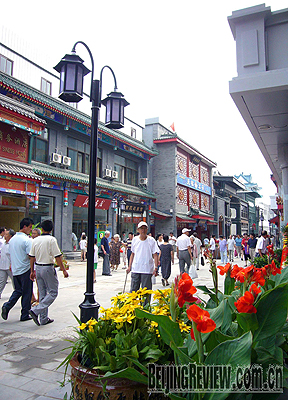|
 |
|
NEW CHARM: Shoppers stroll down the newly renovated Qianmen Street (NEWSPHOTO) |
After a half-century absence the diangdiang tramcar has reappeared on Qianmen Street, Beijing's oldest and most famous commercial street. It's a sign of the times-Beijing going modern with an old twist-that reflects the country's rapid modernization combined with a rising desire to preserve its culture.
Located in Chongwen District, Qianmen is close to Tiananmen Square and the site of many well-known shops. It was first prosperous in the Yuan Dynasty (1279-1368) and was regarded as a symbol of Beijing's wealth.
"Qianmen concentrates the city's culture and has been the site of many big events in Beijing's history," said Zhao Shu, Vice Chairman of the Beijing Cultural Association.
Qianmen Street was closed in May 2007 for its largest renovation project in 600 years. The renovation work was intended to smarten up the street while retaining its old Beijing feel.
Early transportation
The return of diangdiang tramcar is just one part of the restoration project. In the old days the tramcar driver had to stamp on the footboard to make the bell hanging in front of the car ring as he drove down the narrow street. People named the tramcar diangdiang after the sound of the bell.
Diangdiang was the earliest modern transportation in Beijing. It was officially put into use in Qianmen on December 17, 1924 and was cancelled in 1958.
At first, diangdiang tramcar adopted a French style, before switching to a Japanese style and finally Chinese. The new tramcars are in the original 1924 French style and allow drivers to stand at either end.
There are few photographs of the old tramcars left, so making modern replicas has been a difficult task. The newly made diangdiang tramcars are identical to the originals, and include antique wooden decorations and the old bells. They have also adopted advanced technology and materials to make them run more efficiently and to prevent environmental damage.
The tramcars start their journey at Wupailou. Built in the Qing Dynasty (1644-1911), it was the biggest wooden archway in Beijing, and was pulled down by the government in 1958. In 2001, it was reconstructed according to the outlook of the old archway. The only change was that four of its six posts were hung in the air to reduce their influence on the tramline. It was later pulled down again. This time it has been rebuilt in its exact original location and with the original design, using old photographs as a reference.
Imperial Road
Wupailou leads onto a stone rather than concrete road, made of white and gray stone, that creates an air of antiquity.
According to historic records, emperors would pass along Qianmen at least twice a year, so it became known as the imperial road. Restoration work on the road has used 2,000 square meters of white stone and 18,000 square meters of gray.
| 
